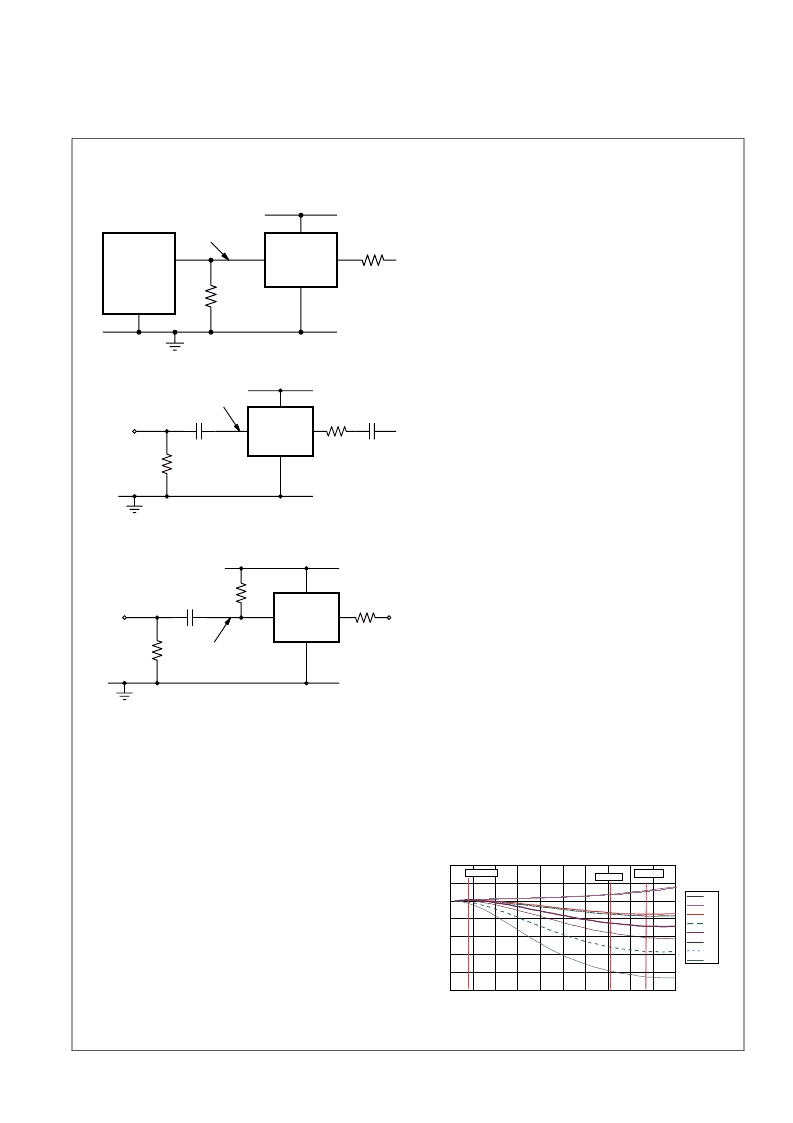- 您現在的位置:買賣IC網 > PDF目錄375863 > FMS6243MTC14X (FAIRCHILD SEMICONDUCTOR CORP) Low-Cost, 3-Channel, SD Video Filter Drivers with External Delay Control PDF資料下載
參數資料
| 型號: | FMS6243MTC14X |
| 廠商: | FAIRCHILD SEMICONDUCTOR CORP |
| 元件分類: | 消費家電 |
| 英文描述: | Low-Cost, 3-Channel, SD Video Filter Drivers with External Delay Control |
| 中文描述: | SPECIALTY CONSUMER CIRCUIT, PDSO14 |
| 封裝: | 4.40 MM, ROHS COMPLIANT, MO-153AB, TSSOP-14 |
| 文件頁數: | 6/10頁 |
| 文件大?。?/td> | 476K |
| 代理商: | FMS6243MTC14X |

2007 Fairchild Semiconductor Corporation
FMS6243 Rev. 1.0.0
www.fairchildsemi.com
6
The same circuits can be used with AC-coupled outputs
if desired. Here is the DC-coupled input with an AC-cou-
pled output.
Figure 9. DC-Coupled Inputs, AC-Coupled Outputs
Figure 10. AC-coupled Inputs and Outputs
Figure 11. Biased AC-Coupled Inputs with
AC-Coupled Outputs
NOTE:
The video tilt or line time distortion is dominated
by the AC-coupling capacitor. The value may need to be
increased beyond 220μF to obtain satisfactory operation
in some applications.
Power Dissipation
The output drive configuration must be considered when
calculating overall power dissipation. Care must be taken
not to exceed the maximum die junction temperature.
The following example can be used to calculate power
dissipation and internal temperature rise:
T
j
= T
A
+ P
d
Θ
JA
where:
P
d
= P
CH1
+ P
CH2
+ P
CH3
and P
CHx
= V
s
I
CH
- (V
O2
/R
L
)
where:
V
O
= 2V
in
+ 0.280V
I
CH
= (I
CC
/ 3) + (V
O
/R
L
)
V
IN
= RMS value of input signal
I
CC
= 24mA
V
s
= 5V
R
L
= channel load resistance
Board layout can also affect thermal characteristics.
Refer to the
Layout Considerations
section for more
information.
The FMS6243 is specified to operate with output cur-
rents typically less than 50mA, more than sufficient for a
dual (75
Ω
) video load. Internal amplifiers are current lim-
ited to a maximum of 100mA and should withstand brief-
duration, short-circuit conditions; however, this capability
is not guaranteed.
Group Delay Adjustment
The FMS6243 has the ability to independently adjust
each channel for Sin X/X group delay and Chroma/Luma
delay. This is accomplished by placing a capacitor from
the device delay adjust pin to ground. The group delay
can be adjusted from the nominal of +10ns to -80ns. This
means that, under a nominal situation, a video system
may have an overall group delay measurement of
+50ns. If the system specification is +40ns, the
FMS6243 could be used to decrease this group delay to
fall well within specification with a guard band to allow for
system variation.
Adding a 50pF capacitor to the desired channel DCap
pin (see Figure 15) generates a -20ns delay through the
FMS6243, which, when summed with the +50ns of the
system, gives a new system overall group delay of
+30ns. It now meets the system specification with a
+10ns guard band for system group delay variation.
Figure 12 shows the effect on group delay by adding
capacitance to the FMS6243 DCap pins. The correct
capacitor can be chosen by determining the format of the
video system (NTSC 3.58 or PAL 4.43), then choosing
the desired group delay to sum with overall system
delay. The desired delay and format line intersection is
the delay capacitor needed for the DCap pins.
Figure 12. Group Delay vs. Delay Cap. Value
DVD or
STB
SoC
DAC
Output
75
Ω
LCVF
Clamp
Inactive
0V - 1.4V
LCVF
Clamp
Active
0.1μ
External video
source must
be AC coupled
0V - 1.4V
220μ
75Ω
75Ω
LCVF
Bias
Input
0.1μ
External video
source must
be AC coupled
500mV +/-350mV
75Ω
7.5MΩ
75Ω
-100
-80
-60
-40
-20
0
20
40
0.0
0.5
1.0
1.5
2.0
Frequency (MHz)
2.5
3.0
3.5
4.0
4.5
5.0
G
10pF
20pF
30pF
40pF
50pF
60pF
70pF
80pF
400kHz Ref
3.58MHz
4.43MHz
相關PDF資料 |
PDF描述 |
|---|---|
| FMS6243 | Low-Cost, 3-Channel, SD Video Filter Drivers with External Delay Control |
| FMS6243MTC14 | Low-Cost, 3-Channel, SD Video Filter Drivers with External Delay Control |
| FMS6246MTC209 | Six Channel, 6th Order SD/PS Video Filter Driver |
| FMS6246 | Six Channel, 6th Order SD/PS Video Filter Driver |
| FMS6246-9 | Six Channel, 6th Order SD/PS Video Filter Driver |
相關代理商/技術參數 |
參數描述 |
|---|---|
| FMS6246 | 制造商:FAIRCHILD 制造商全稱:Fairchild Semiconductor 功能描述:Six Channel, 6th Order SD/PS Video Filter Driver |
| FMS6246_06 | 制造商:FAIRCHILD 制造商全稱:Fairchild Semiconductor 功能描述:Six Channel, 6th Order SD/PS Video Filter Driver |
| FMS6246-9 | 制造商:FAIRCHILD 制造商全稱:Fairchild Semiconductor 功能描述:Six Channel, 6th Order SD/PS Video Filter Driver |
| FMS6246MTC20 | 功能描述:視頻 IC Ang fg 6Chanl 6thOrd SD/PSVidFiltrDr RoHS:否 制造商:Fairchild Semiconductor 工作電源電壓:5 V 電源電流:80 mA 最大工作溫度:+ 85 C 封裝 / 箱體:TSSOP-28 封裝:Reel |
| FMS6246MTC209 | 制造商:FAIRCHILD 制造商全稱:Fairchild Semiconductor 功能描述:Six Channel, 6th Order SD/PS Video Filter Driver |
發(fā)布緊急采購,3分鐘左右您將得到回復。